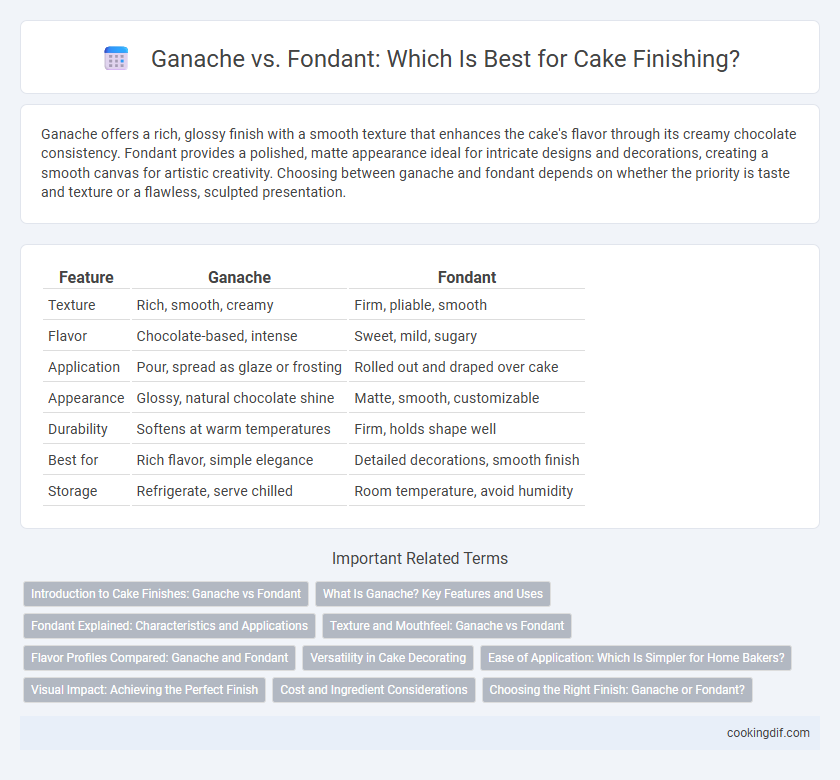Ganache offers a rich, glossy finish with a smooth texture that enhances the cake's flavor through its creamy chocolate consistency. Fondant provides a polished, matte appearance ideal for intricate designs and decorations, creating a smooth canvas for artistic creativity. Choosing between ganache and fondant depends on whether the priority is taste and texture or a flawless, sculpted presentation.
Table of Comparison
| Feature | Ganache | Fondant |
|---|---|---|
| Texture | Rich, smooth, creamy | Firm, pliable, smooth |
| Flavor | Chocolate-based, intense | Sweet, mild, sugary |
| Application | Pour, spread as glaze or frosting | Rolled out and draped over cake |
| Appearance | Glossy, natural chocolate shine | Matte, smooth, customizable |
| Durability | Softens at warm temperatures | Firm, holds shape well |
| Best for | Rich flavor, simple elegance | Detailed decorations, smooth finish |
| Storage | Refrigerate, serve chilled | Room temperature, avoid humidity |
Introduction to Cake Finishes: Ganache vs Fondant
Ganache and fondant are two popular cake finishes that offer distinct textures and visual effects. Ganache, made from chocolate and cream, provides a rich, glossy finish with a smooth, creamy texture ideal for drip cakes and elegant coverings. Fondant, composed primarily of sugar, water, and gelatin, creates a pliable, matte surface perfect for sculpted designs and intricate decorations.
What Is Ganache? Key Features and Uses
Ganache is a rich, smooth mixture of chocolate and cream that creates a glossy, velvety finish ideal for glazing or filling cakes. Its key features include a creamy texture, versatility in consistency--from pourable glaze to firm frosting--and the ability to enhance flavor depth with various types of chocolate. Ganache is commonly used for coating cakes, making truffles, and adding a luxurious, decadent touch to desserts.
Fondant Explained: Characteristics and Applications
Fondant is a smooth, pliable icing made primarily from sugar, water, and gelatin, providing a sleek, polished finish ideal for intricate cake decorations and sculpting. Its rollable texture allows for seamless coverage and detailed designs, making it a preferred choice for wedding and celebration cakes. Unlike ganache, fondant offers a sweeter taste and firmer texture, enhancing both aesthetic appeal and structural versatility in cake finishing.
Texture and Mouthfeel: Ganache vs Fondant
Ganache offers a rich, smooth, and creamy texture that melts effortlessly in the mouth, delivering a luxurious and velvety mouthfeel ideal for decadent cakes. Fondant provides a firm, pliable exterior with a slightly chewy texture that creates a polished and sculpted finish, enhancing visual appeal but resulting in a denser bite. Choosing ganache emphasizes luscious softness and intense chocolate flavor, while fondant prioritizes structural integrity and a sweet, dough-like sensation on the palate.
Flavor Profiles Compared: Ganache and Fondant
Ganache offers a rich, creamy texture with intense chocolate flavor that enhances the cake's depth and moistness, appealing to chocolate lovers seeking indulgence. Fondant provides a smooth, sweet, and mildly vanilla-flavored finish, ideal for intricate decorating and a clean, polished look but with a less pronounced taste. Choosing between ganache and fondant depends on whether flavor richness or decorative versatility is prioritized in cake finishing.
Versatility in Cake Decorating
Ganache offers a rich, smooth texture ideal for creating glossy finishes, drip effects, and natural, decadent layers, making it highly versatile for a variety of cake designs. Fondant provides a pliable, matte surface perfect for intricate sculpting, vibrant colors, and detailed decorations, allowing precise customization in cake artistry. Both ganache and fondant enhance cake decorating versatility by catering to different aesthetic and textural preferences.
Ease of Application: Which Is Simpler for Home Bakers?
Ganache offers a smoother, more forgiving texture that melts easily over cakes, making it a preferred choice for home bakers seeking simplicity in application. Fondant requires precise rolling and kneading to achieve a uniform surface, which can be challenging without experience. The ease of spreading ganache with a spatula often surpasses the meticulous process of smoothing fondant, especially for beginners.
Visual Impact: Achieving the Perfect Finish
Ganache offers a smooth, glossy finish that enhances the cake's natural texture, providing a rich and luxurious visual appeal ideal for elegant designs. Fondant delivers a matte, polished appearance with a flawless surface that allows for intricate decorations and vibrant color application, making it perfect for detailed, themed cakes. Choosing between ganache and fondant depends on the desired visual impact, whether prioritizing natural shine and decadence or a sculpted, clean canvas for artistic expression.
Cost and Ingredient Considerations
Ganache, made from a simple mixture of chocolate and cream, offers a rich and smooth finish at a lower cost compared to fondant, which requires more specialized ingredients like gelatin, glucose, and glycerin, making it pricier. Fondant provides a polished, pliable covering ideal for intricate decorations, but its ingredients contribute to higher expenses and longer preparation times. Choosing between ganache and fondant depends on budget constraints and the desired cake texture, with ganache appealing to cost-conscious bakers seeking intense chocolate flavor and fondant favored for elaborate aesthetic finishes.
Choosing the Right Finish: Ganache or Fondant?
Ganache offers a rich, glossy finish with a smooth texture that enhances the flavor of chocolate cakes, making it ideal for a luxurious, indulgent dessert. Fondant provides a sleek, polished look with a smooth, pliable surface perfect for detailed decorations and a professional appearance. When choosing the right finish, consider ganache for a decadent taste experience and fondant for intricate designs and a flawless, elegant presentation.
Ganache vs Fondant for finishing Infographic

 cookingdif.com
cookingdif.com